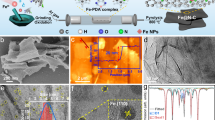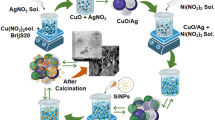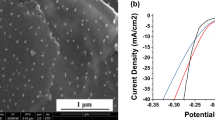Abstract
Herein, hydrophobic tannic acid–iron (TA–Fe) coordination composites were encapsulated within polystyrene-copolyacrylonitrile (PS-c-PAN) nanospheres using the flash nanoprecipitation (FNP) technique. Carbon materials with uniform and dense distributions of metal NPs were obtained after carbonization under the protection and confinement of the polymer matrix. The as-prepared Fe and nitrogen codoped carbon materials exhibited enhanced electrocatalytic performance in the oxygen reduction reaction (ORR) and oxygen evolution reaction (OER). In addition, the catalytic ability of the carbon/metal composites could be affected by tuning the morphology and composition.
Highlights
The flash nanoprecipitation (FNP) technique was employed to prepare polymer nanomaterial-entrapped metal precursors.
The confinement function of polymers ensured a uniform distribution of metal NPs within the carbon matrix after carbonization.
The morphology and electrocatalytic activities of the obtained catalysts could be varied by changing the processing parameters.
This is a preview of subscription content, access via your institution
Access options
Subscribe to this journal
Receive 12 print issues and online access
$259.00 per year
only $21.58 per issue
Buy this article
- Purchase on Springer Link
- Instant access to full article PDF
Prices may be subject to local taxes which are calculated during checkout





Similar content being viewed by others
References
Liu MM, Zhang RZ, Chen W. Graphene-supported nanoelectrocatalysts for fuel cells: synthesis, properties, and applications. Chem Rev. 2014;114:5117–60.
Zhao J, Qin RX, Liu R. Urea-bridging synthesis of nitrogen-doped carbon tube supported single metallic atoms as bifunctional oxygen electrocatalyst for zinc-air battery. Appl Catal B—Environ. 2019;256:117778–86.
Lee DU, Xu P, Cano ZP, Kashkooli AG, Park MG, Chen ZW. Recent progress and perspectives on bi-functional oxygen electrocatalysts for advanced rechargeable metal-air batteries. J Mater Chem A. 2016;4:7107–34.
Zhao J, Li CL, Liu R. Enhanced oxygen reduction of multi-Fe3O4@carbon core–shell electrocatalysts through a nanoparticle/polymer co-assembly strategy. Nanoscale. 2018;10:5882–7.
Debe MK. Electrocatalyst approaches and challenges for automotive fuel cells. Nature. 2012;486:43–51.
Lee Y, Suntivich J, May KJ, Perry EE, Horn YS. Synthesis and activities of rutile IrO2 and RuO2 nanoparticles for oxygen evolution in acid and alkaline solutions. J Phys Chem Lett. 2012;3:399–404.
Qian YH, Hu ZG, Ge XM, Yang SL, Peng YW, Kang ZX, et al. A metal-free ORR/OER bifunctional electrocatalyst derived from metal-organic frameworks for rechargeable Zn–Air batteries. Carbon. 2017;111:641–50.
Su HY, Gorlin Y, Man IC, Calle-Vallejo F, Nørskov JK, Jaramillo TF, et al. Identifying active surface phases for metal oxide electrocatalysts: a study of manganese oxide bi-functional catalysts for oxygen reduction and water oxidation catalysis. Phys Chem Chem Phys. 2012;14:14010–22.
Esposito DV, Chen JG. Monolayer platinum supported on tungsten carbides as low-cost electrocatalysts: opportunities and limitations. Energy Environ Sci. 2011;4:3900–12.
Ding W, Wei ZD, Chen SG, Qi XQ, Yang T, Hu JS et al. Space-confinement-induced synthesis of pyridinic- and pyrrolic-nitrogen-doped graphene for the catalysis of oxygen reduction. Angew Chem Int Ed. 2013;52:11755–9.
Zheng Y, Jiao Y, Chen J, Liu J, Liang J, Du AJ, et al. Nanoporous graphitic-C3N4@carbon metal-free electrocatalysts for highly efficient oxygen reduction. J Am Chem Soc. 2011;133:20116–9.
Carver CT, Matson BD, Mayer JM. Electrocatalytic oxygen reduction by iron tetra-arylporphyrins bearing pendant proton relays. J Am Chem Soc. 2012;134:5444–7.
Samanta S, Sengupta K, Mittra K, Bandyopadhyay S, Dey A. Selective four electron reduction of O2 by an iron porphyrin electrocatalyst under fast and slow electron fluxes. Chem Commun. 2012;48:7631–3.
Lin L, Zhu Q, Xu AW. Noble-metal-free Fe-N/C catalyst for highly efficient oxygen reduction reaction under both alkaline and acidic conditions. J Am Chem Soc. 2014;136:11027–33.
Lin QP, Bu XH, Kong AG, Mao CY, Bu F, Feng PY. Heterometal-embedded organic conjugate frameworks from alternating monomeric iron and cobalt metalloporphyrins and their application in design of porous carbon catalysts. Adv Mater. 2015;27:3431–6.
Lin QP, Bu XH, Kong AG, Mao CY, Zhao X, Bu F, et al. New heterometallic zirconium metalloporphyrin frameworks and their heteroatom-activated high-surface-area carbon derivatives. J Am Chem Soc. 2015;137:2235–8.
Dai Y, Zhu GD, Shang XH, Zhu TZ, Yang JM, Liu JY. Electrospun zirconia-embedded carbon nanofibre for high-sensitive determination of methyl parathion. Electrochem Commun. 2017;81:14–7.
Mahendran V, Philip J. Sensing of biologically important cations such as Na+, K+, Ca2+, Cu2+, and Fe3+ using magnetic nanoemulsions. Langmuir. 2013;29:4252–8.
Zhou D, Yang LP, Yu LH, Kong JH, Yao XY, Liu WS, et al. Fe/N/C hollow nanospheres by Fe(III)-dopamine complexation-assisted one-pot doping as nonprecious-metal electrocatalysts for oxygen reduction. Nanoscale. 2015;7:1501–9.
Li CL, Zhang ZJ, Wu MC, Liu R. FeCoNi ternary alloy embedded mesoporous carbon nanofiber: an efficient oxygen evolution catalyst for rechargeable zinc-air battery. Mater Lett. 2019;238:138–42.
Li CL, Wu MC, Liu R. High-performance bifunctional oxygen electrocatalysts for zinc-air batteries over mesoporous Fe/Co-N-C nanofibers with embedding FeCo alloy nanoparticles. Appl Catal B—Environ. 2019;244:150–8.
Zhang C, Pansare VJ, Prud’hommea RK, Priestley RD. Flash nanoprecipitation of polystyrene nanoparticles. Soft Matter. 2012;8:86–93.
Grundy LS, Lee VE, Li N, Sosa C, Mulhearn WD, Liu R, et al. Rapid production of internally structured colloids by flash nanoprecipitation of block copolymer blends. ACS Nano. 2018;12:4660–8.
Liu R, Priestley RD. Rational design and fabrication of core-shell nanoparticles through a one-step/pot strategy. J Mater Chem A. 2016;4:6680–92.
Xue XY, Yu F, Peng BH, Wang G, Lv Y, Chen L, et al. One-step synthesis of nickel-iron layered double hydroxides with tungstate acid anions via flash nano-precipitation for the oxygen evolution reaction. Sustain Energ Fuels. 2019;3:237–44.
Liu R, Sosa C, Yeh YW, Qu FL, Yao N, Prud’hommea RK, et al. A one-step and scalable production route to metal nanocatalyst supported polymer nanospheres via flash nanoprecipitation. J Mater Chem A. 2014;2:17286–90.
D’Addio SM, Prud’homme RK. Controlling drug nanoparticle formation by rapid precipitation. Adv Drug Deliv Rev. 2011;63:417–26.
Zhang ZJ, Sun L, Liu R. Flash nanoprecipitation of polymer supported Pt colloids with tunable catalytic chromium reduction property. Colloid Polym Sci. 2018;296:327–33.
Zhu ZX, Xu P, Fan GK, Liu NN, Xu SQ, Li XL, et al. Fast synthesis and separation of nanoparticles via in-situ reactive flash nanoprecipitation and pH tuning. Chem Eng J. 2019;356:877–85.
Zhu ZX. Flash nanoprecipitation: prediction and enhancement of particle stability via drug structure. Mol Pharm. 2014;11:776–86.
Gindy ME, Panagiotopoulos AZ, Prud’homme RK. Composite block copolymer stabilized nanoparticles: simultaneous encapsulation of organic actives and inorganic nanostructures. Langmuir. 2008;24:83–90.
Tang C, Amin D, Messersmith PB, Anthony JE, Prud’homme RK. Polymer directed self-assembly of pH-responsive antioxidant nanoparticles. Langmuir. 2015;31:3612–20.
Li CL, Zhao J, Priestley RD, Liu R. Constrained-volume assembly of organometal confined in polymer to fabricate multi-heteroatom doped carbon for oxygen reduction reaction. Sci China Mater. 2018;61:1305–13.
Li Q, Zhao J, Wu MC, Li CL, Han L, Liu R. Hierarchical porous N-doped carbon nanofibers supported Fe3C/Fe nanoparticles as efficient oxygen electrocatalysts for Zn–air batteries. ChemistrySelect. 2019;4:1–8.
Pinkerton NM, Hadri K, Amouroux B, Behar L, Mingotaud C, Destarac M, et al. Quench ionic flash nano precipitation as a simple and tunable approach to decouple growth and functionalization for the one-step synthesis of functional LnPO4-based nanoparticles in water. Chem Commun. 2018;54:9438–41.
Zhao J, Lee VE, Liu R, Priestley RD. Responsive polymers as smart nanomaterials enable diverse applications. Annu Rev Chem Biomol Eng. 2019;10:361–82.
Yang TT, Li KX, Pu LT, Liu ZQ, Ge BC, Pan YJ, et al. Hollow-spherical Co/N-C nanoparticle as an efficient electrocatalyst used in air cathode microbial fuel cell. Biosens Bioelectron. 2016;86:129–34.
Li XY, Jiang QQ, Dou S, Deng LB, Huo J, Wang SY. ZIF-67-derived Co-NC@CoP-NC nanopolyhedra as an efficient bifunctional oxygen electrocatalysts. J Mater Chem A. 2016;4:15836–40.
Lu YZ, Jiang YY, Gao XH, Wang XD, Chen W. Strongly coupled Pd nanotetrahedron/tungsten oxide nanosheet hybrids with enhanced catalytic activity and stability as oxygen reduction electrocatalysts. J Am Chem Soc. 2014;136:11687–97.
Zhao J, Fu N, Liu R. Graphite-wrapped Fe core-shell nanoparticles anchored on graphene as pH-universal electrocatalyst for oxygen reduction reaction. ACS Appl Mater Interfaces. 2018;10:28509–16.
Wang J, Li S, Zhu G, Zhao W, Chen R, Pan M. Novel non-noble metal electrocatalysts synthesized by heat-treatment of iron terpyridine complexes for the oxygen reduction reaction. J Power Sources. 2013;240:381–9.
Ye S, Vijh AK. Non-noble metal-carbonized aerogel composites as electrocatalysts for the oxygen reduction reaction. Electrochem Commun. 2003;5:272–5.
Li S, Zhang L, Liu H, Pan M, Zan L, Zhang J. Heat-treated cobalt–tripyridyl triazine (Co–TPTZ) electrocatalysts for oxygen reduction reaction in acidic medium. Electrochim Acta. 2010;55:4403–11.
Xiong J, Zhao J, Xiang Z, Li CL, Wu MC, Wang X, et al. Carbon nanotube@ZIF–derived Fe-N-doped carbon electrocatalysts for oxygen reduction and evolution reactions. J Solid State Electrochem. 2019;23:2225–32.
Acknowledgements
We would like to acknowledge the National Natural Science Foundation of China (21774095), Shanghai Municipal Natural Science Foundation (17ZR1432200), start-up funding from Tongji University and the Young Thousand Talented Program.
Author information
Authors and Affiliations
Corresponding author
Ethics declarations
Conflict of interest
The authors declare that they have no conflict of interest.
Additional information
Publisher’s note Springer Nature remains neutral with regard to jurisdictional claims in published maps and institutional affiliations.
Supplementary information
Rights and permissions
About this article
Cite this article
Wang, J., Zhang, Z., Zhao, J. et al. Pyrolysis of a flash nanoprecipitated tannic acid–metal@polymer assembly to create an electrochemically active metal@nanocarbon catalyst. Polym J 52, 539–547 (2020). https://doi.org/10.1038/s41428-020-0305-1
Received:
Revised:
Accepted:
Published:
Issue Date:
DOI: https://doi.org/10.1038/s41428-020-0305-1



